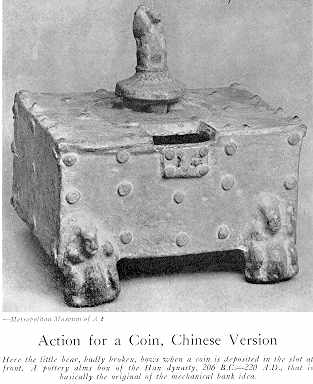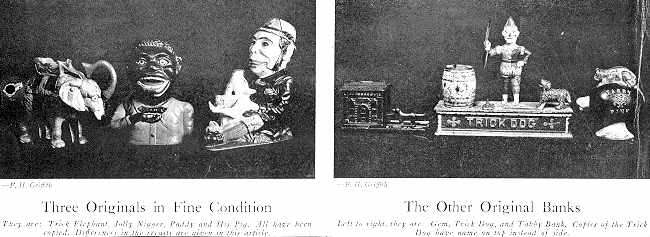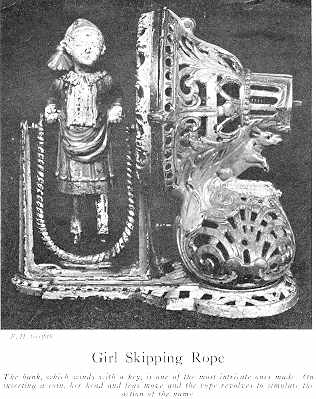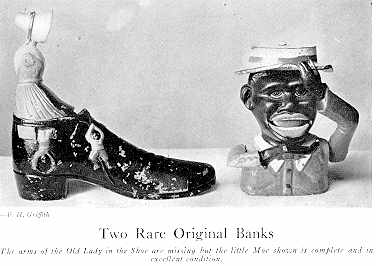This article is also available
in full page images - click here (1600k)
AMERICAN COLLECTOR, September 1938, By Ruth Webb Lee
Mechanical Banks, Old and New

T
HE Wonder is not that so many successful business and professional men have of recent years taken to collecting old mechanical cast iron banks, but that they did not begin long ago. There is a generally ignored sentimental side. With age we begin to walk backwards to that past when dreams easily turn into reckless impulses, until experience furnishes safety brakes. You will find that the majority of mechanical bank collectors are grown men, though youth is not immune to the appeal of memory. I used to save pennies. The mechanical comedy of the banks made me laugh and, at the same time, made me richer. It is well to laugh when we make money, and in my day we were assured that a penny saved, is a penny earned. It is not necessary to be a tight-wad to believe in Poor Richard’s wisdom. After all, the extremely ingenious penny-gulping little machines decidedly reflect the American spirit in sundry ways. More over, if whatever you associate with the happy days of your youth imparts a sentimental quality to bank collecting, it is also well to remember that one does not have to belong to the 60 families of the United States to be able to indulge in this popular hobby. As in all lines of antiques, there are fairly common banks as well as interesting rarities. The scarcer pieces naturally command high prices.The road of the bank collector is not without its pitfalls. Reproductions were bound to appear as the fad grew, but these can all be listed. If collectors and dealers will take the trouble to note carefully the differences between the old and the new, there need be no great fear about the reproductions. They are all illustrated here from genuine old banks, with the exception of the Trick Monkey, which is of little importance. The recasts are the banks that one must guard against, for it is often difficult to distinguish them, even when placed alongside of the originals.

Among the banks which have been copied are the Jolly Nigger, Trick Dog, Tabby, Paddy and His Pig, Trick Elephant, and the Gem. All are illustrated. The nomenclature of banks is generally derived from the printed names on them. Thus, the Tabby bank has a cat reclining on an egg, which has a ludicrous chicken’s head protruding from one end. The egg-shaped part bears the name Tabby Bank. Some banks are labeled on the front side and some on the reverse; others are not inscribed at all. For the latter, home-made descriptive titles have sprung into general use, just as descriptive titles tagged many a piece of pattern glass before an accurate nomenclature became standardized.
Such banks as the Trick Monkey are about 15 years old. They are still being made. Collectors can distinguish the 15-year-old variety by studying the surface, since new paint simply cannot be made to look old by wearing off portions of it; by chipping it off; or by banging up the bank generally. This bank has little value as a collectors item.
There are old Trick Dog and Trick Elephant banks. The new Trick Dog has a solid base and is badly painted, whereas the base of the old is composed of four pieces and dated 1888. The name Trick Dog is cast in the front side of the bank; the new one has the name on the top.
The new and old Trick Elephants are less easy to distinguish. The new one is painted white and the old one is gray. Of course new ones can be repainted gray. It is up to the buyer to judge whether it is a repainted bank, or whether what he sees is a natural accumulation of grime and dirt from handling.
So far, the recasting of banks has been very limited due to the amount of work involved. Most of those so far copied have been of the more common variety, and hardly worth the time and energy necessary to do them right. The Paddy and His Pig bank is the best of the old ones copied, in the matter of scarcity and value. Just why such a complicated bank was chosen is difficult to understand. In the recast specimens the parts are all heavier and fit together poorly. The paint, instead of being smooth, is pebbly because the casting is rough. There is a smoothness in the feel of old paint and an appearance of age that, to an experienced collector, tells the story. Inexperienced buyers before purchasing a Paddy and His Pig should be sure of the source.
This bank was made in a New England factory and its probable popularity was suggested by the heavy immigration from Ireland. Obviously this bank dates from a time when Irish comedians were in demand. It is said that an Irish society requested that this bank cease to be manufactured, because it constituted an insult to the race. Members did not wish to be associated in the public’s mind with pigs. Moreover, Paddy is clutching the animal to the point of suffocation. Sandy, the Scotchman, might squeeze an asset that tightly — but not an Irishman.
About the new Gem bank the same story may be written: namely, rough casting and poor paint job. Also the parts are heavier.
The various difficulties in the matter of recastings are well worth knowing. First, the composition of the cast iron used today is different than in the old banking days. Many malleable castings were used in the old banks; today nickel has been adapted, which makes the recast banks more brittle and hard.
Most of the iron in the old banks was smooth and soft on the surface. A very fine sand was used and there were many gates on each piece. The fine sand made the casting smooth, whole, and perfect. Today, the sand is coarse and only one gate will be used in pouring a piece. (A gate is the metal ear, or piece, left on the casting when it is taken from the mold.) The gates are later removed or filed smooth on the finished article. In recasting copies of old banks, graphite has been used in an effort to make the casting smooth, but it does not work out successfully.
The above explanation can readily apply to the recast Tabby bank. The old one is smooth and worn and made of cast iron. The new one is rough, pebbly, and sometimes appears made in bronze or barss.
The Jolly Nigger is heavy, rough, operates very poorly, and is painted gaudily, though not gaudily enough to cover the pebbly surface.
Since the collecting of old iron mechanical banks has grown in popularity, one might expect many other new ones to come on the market, but it is doubtful if this will happen for several reasons. Today, manufacturers must count on mass production on cheap articles and most of the banks are made up of intricate parts which are not easy to assemble, thereby necessitating considerable labor, which means higher unit cost. During the 1880’s and 1890’s, when there banks were most popular, labor costs were but a fraction of what prevail today.

Among the more intricate banks, probably the most clever is the Girl Skipping Rope. This bank winds with a key. When the coin is inserted she turns her head from side to side, moves her legs back and forth, and rises up and down as the rope revolves. It took considerable time and skill to assemble this bank and make it work properly. It sold for $1.00 during the 1890’s. Think what it would cost to manufacture it today! Then, too, banks which were made in many pieces in the old bank era would be cast in one or two pieces today, so they would be nothing like the originals. The reason many pieces were used and the castings so thin, was due to the fact that metal was a more expensive item then than now.

Two real rarities in banks are illustrated, Little Moe the colored boy and Old Lady in the Shoe. The latter is only part of the bank, the balance having been lost. It is not of cast iron, but of a white metal of some sort. This example may be a trial casting or model.
The collection of mechanical banks is fairly well protected against recasts in the case of rarities, which go into private collections so quickly that they are never on the market for long. To run across many of the rarest ones in shops would instantly arouse suspicion.
Though there have been rumors of recasts of the Jonah and the Whale bank and the Darktown Battery, not one has come to light so far. If new ones do turn up, they will be readily recognized, as they are elaborate in mechanical detail and the old paint cannot be duplicated. The mechanical bank field, all in all, is fairly clear of reproductions. Fortunately reports about new ones, as they appear in the AMERICAN COLLECTOR and other antiques magazines, will keep dealers and collectors informed.
So warned, neither collectors nor dealers who are careful and intelligently inspect banks offered to them, should be deceived. Practically all recast banks I have seen have details that, if observed, identify them as not being originals.
I am indebted to the well-known collector, Mr. F. H. Griffith of Shrewsbury, Mass., for the loan of his banks, for these photographs, and for his helpful observations on the subject.
